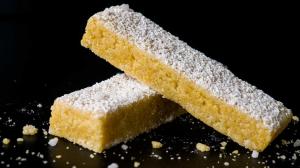YELLOW yet CRUNCHIER version TESTING 1-2-3 . . . I had a craving for shortbreads at the same time that I had a craving for cornbread and polenta. I needed to do some math, so as to figure out what makes a shortbread what it is and what happens if you modify this tried-and-tested basic recipe.
A basic shortbread is truly basic : 1 part sugar, 2 parts butter, 3 parts flour. In other words for 100 grams of sugar, you’ll need 200 grams of butter and 300 grams of flour and the resulting calculations (when you break it all down) yield a protein content of 5%-6%, a fat content of 26%-27% and a carbohydrates content of 52%-53%. A more precise calculation of the proportional ratios would actually be 1:5:10 (which sounds magical to me).
If I wanted something crispier & grainier (or ‘sandier’ because in French, a shortbread is called a ‘sablé’ or sandy cookie) and tastier (even though a regular shortbread is tasty yet simple), I would have to recombine different flours and starches and textures to achieve this, while trying to respect the initial proportions or ratios.
What you see here is the result. FANTASTIC.
It’s still a shortbread cookie. It’s a mellow yellow color below the blindingly white sugar coating (as we do for greek almond ‘kourabiedes’ shortbreads). When you bite into it, it melts in your mouth but tiny grains of sweet cornmeal give it even more taste, body and ‘crunch’ and the finer icing sugar glaze topped with larger sugar crystals just adds to that crunch.
I’ve been making a batch of these once every week now for the past 3 weeks. I should stop, right ?! . . . :)











